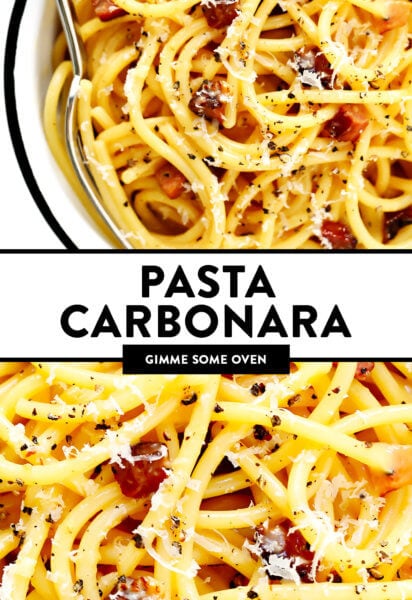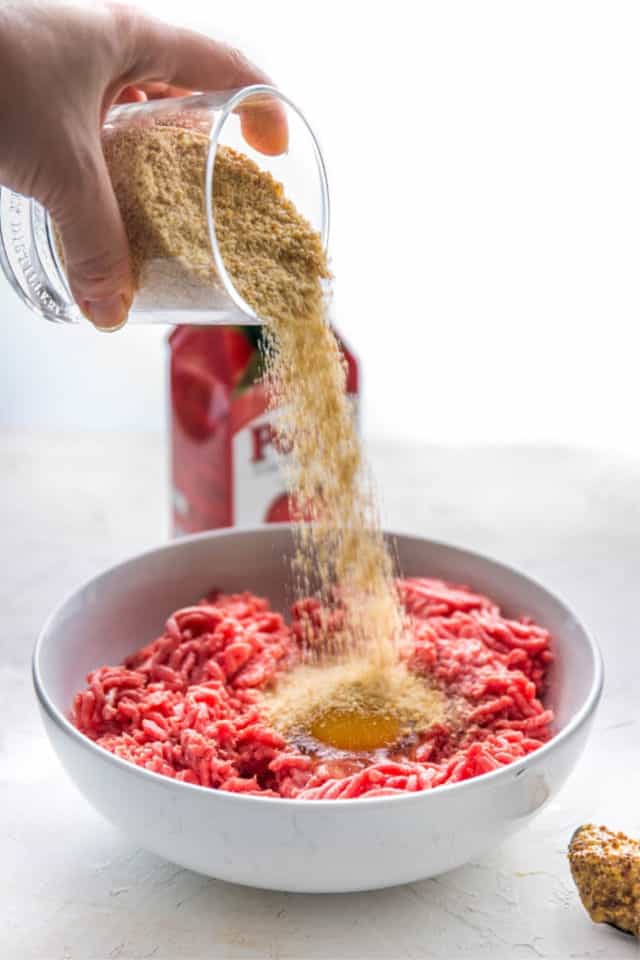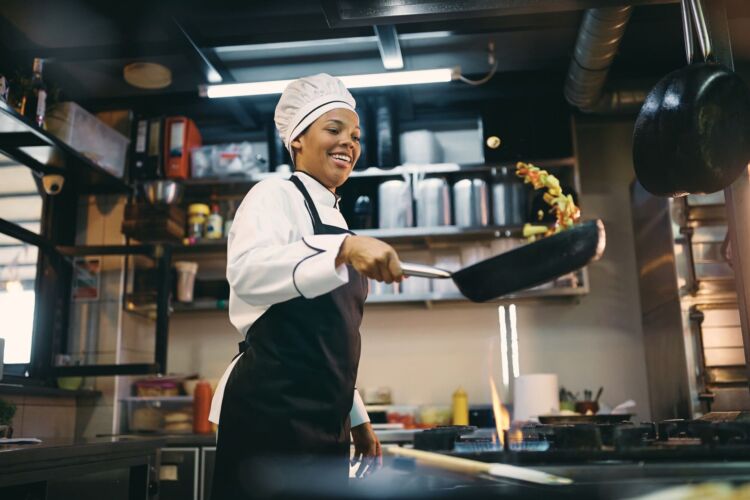Pasta alla Carbonara Recipe | Gimme Some Oven
This post may contain affiliate links. Please read my disclosure policy.
This pasta alla carbonara recipe easy to make with 4 classic ingredients and tastes so decadent and delicious.
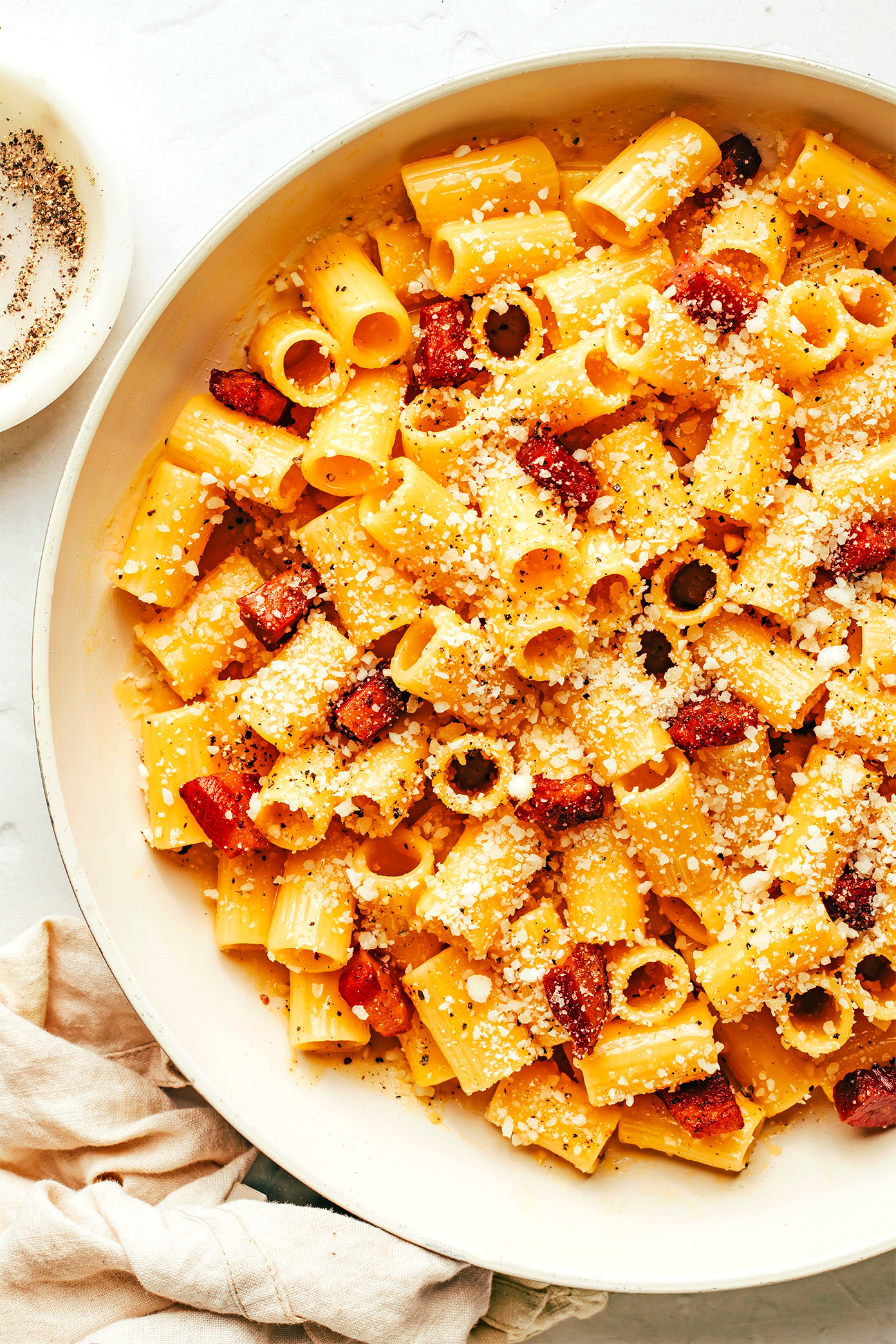
Ok, I couldn’t spend a month in Rome studying and seeking out the best pasta alla carbonara the city had to offer without coming back to this post to share a few things that I learned. ♡
First of all, can I just say how much I appreciate this city’s passion for talking about good pasta?! One of the first souvenirs I purchased during our month in Rome was this tote bag, and the number of nods and conversations it prompted with everyone from market vendors to our AirBnB neighbors to restaurant servers to local playground parents were downright delightful. “That’s right.” “All you need.” “Correct, no cream!” You also can’t help but love a city where everyone, when asked who makes the best carbonara, quickly replies with the obvious —“mia nonna” (my grandmother). Certainly true, I’m sure. But I have to say that the bowls of pasta alla carbonara that I had the pleasure of sampling in restaurants were also exceptional.
My favorite, no surprise, ended up being the pasta alla carbonara developed by the “King of Carbonara” himself, Chef Luciano Monosilio. Served with a supremely decadent and silky egg sauce, a few crispy and surprisingly large cubes of guanciale, and a perfectly al dente twirl of thick spaghetti, Chef Luciano’s carbonara tasted just as legendary as one would hope. And I was also intrigued to learn that he has a brilliant modern method for making it, which I’ve now wholeheartedly adopted.
Instead of tossing the egg sauce in a very hot pan with very hot pasta, a classic method that is notorious for sometimes accidentally scrambling the eggs, Chef Luciano first tempers the eggs in a metal mixing bowl with the guanciale grease and hot starchy pasta water. Then he transfers the pasta directly to the mixing bowl, places the bowl over the pot used to cook the pasta water (essentially creating a double boiler), and tosses the pasta with the sauce over the heat until it has cooked and thickened. It’s a simple method that I’ve found to be much more reliable when it comes to creating a perfectly glossy egg sauce and I have a hunch that all of you fellow carbonara lovers out there are going to love it too.
So today, I’ve updated my favorite pasta alla carbonara recipe below to include the double-boiler trick, along with a few additional tips that will hopefully be helpful. This recipe is definitely full-on rich, full-flavored, classic comfort food. So when you’re ready to indulge, grab a fork and let’s dive in!
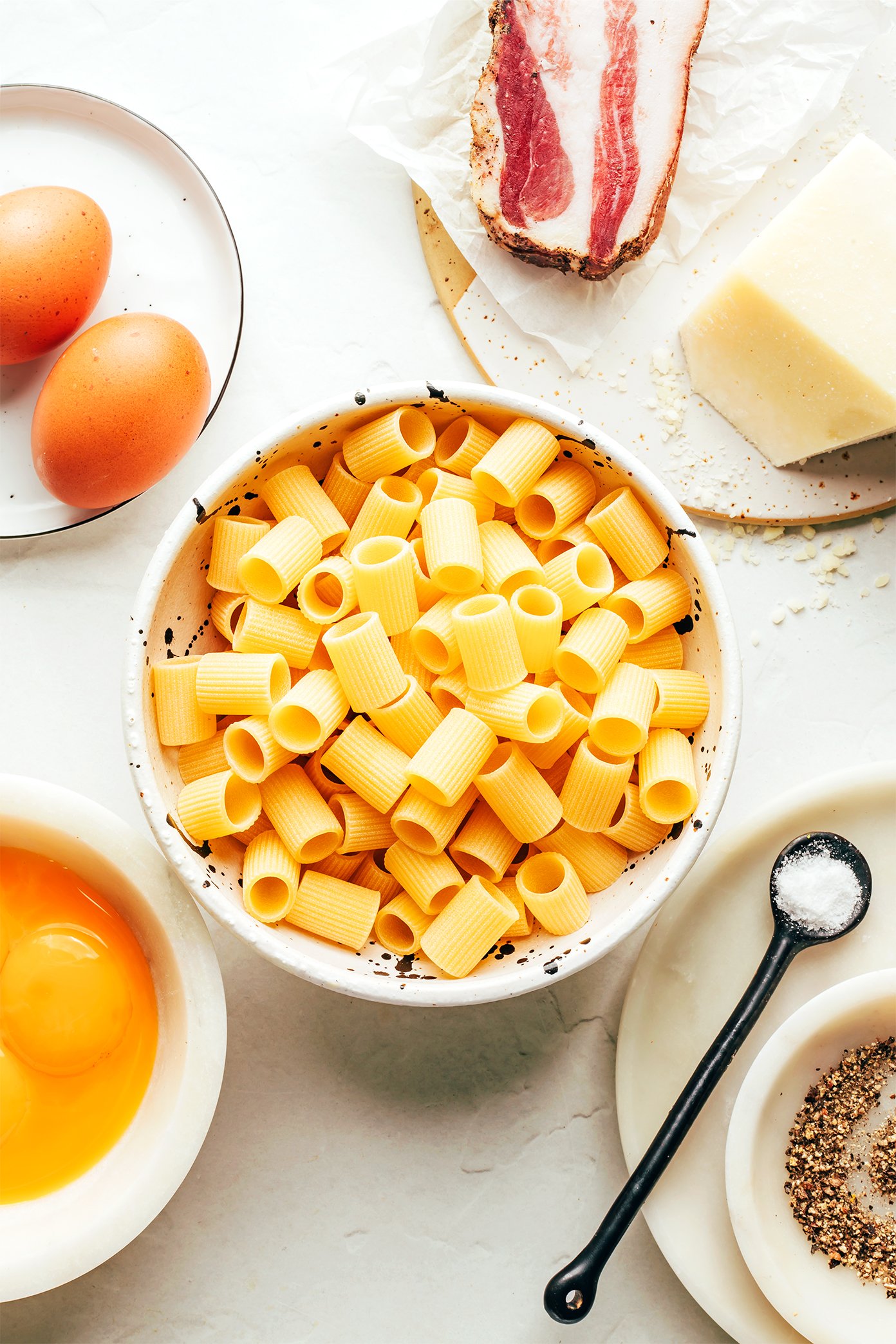
Pasta Carbonara Ingredients
Here are a few notes about the pasta carbonara ingredients that you will need to make this recipe:
- Pasta: Thick spaghetti or rigatoni (I used mezzi rigatoni in the batch photographed here) are the most common pasta shapes traditionally used with carbonara sauce. But of course, the dish will still be delicious with just about any type of pasta shape you have on hand, so it’s up to you.
- Eggs + egg yolks: My Roman friend, Alessio, taught me years ago to always use double the number of yolks as whole eggs in this carbonara.
- Guanciale: Italian cured pork cheek is undoubtedly the starring ingredient in Amatriciana, Gricia and Carbonara. Its rich, salty, intense pork flavor and signature thick crisp-chewy texture is unparalleled in my opinion, and absolutely worth a trip to your local Italian market if guanciale is unavailable at your local grocery store. That said, if you’re unable to track down guanciale locally, thick-cut bacon or pancetta will work as a non-traditional substitute.
- Pecorino Romano: This aged sheep’s cheese is always traditionally used in the Roman pastas, and its salty, grassy, earthy flavor is absolutely delicious in carbonara. That said, if Pecorino is unavailable at your local grocery store, you can use Parmesan as a non-traditional substitute. Or if you want to follow the lead of Chef Luciano Monosilio, you’re welcome to use a 2:3 ratio of Pecorino Romano to Grana Padano.
- Sea salt and freshly-ground black pepper: Guanciale is quite salty and peppery, so you will not need to salt your pasta water as liberally as normal when making carbonara. I still like to add quite a bit of extra freshly-ground black pepper in addition to the guanciale, but you’re welcome to use however much pepper you prefer.
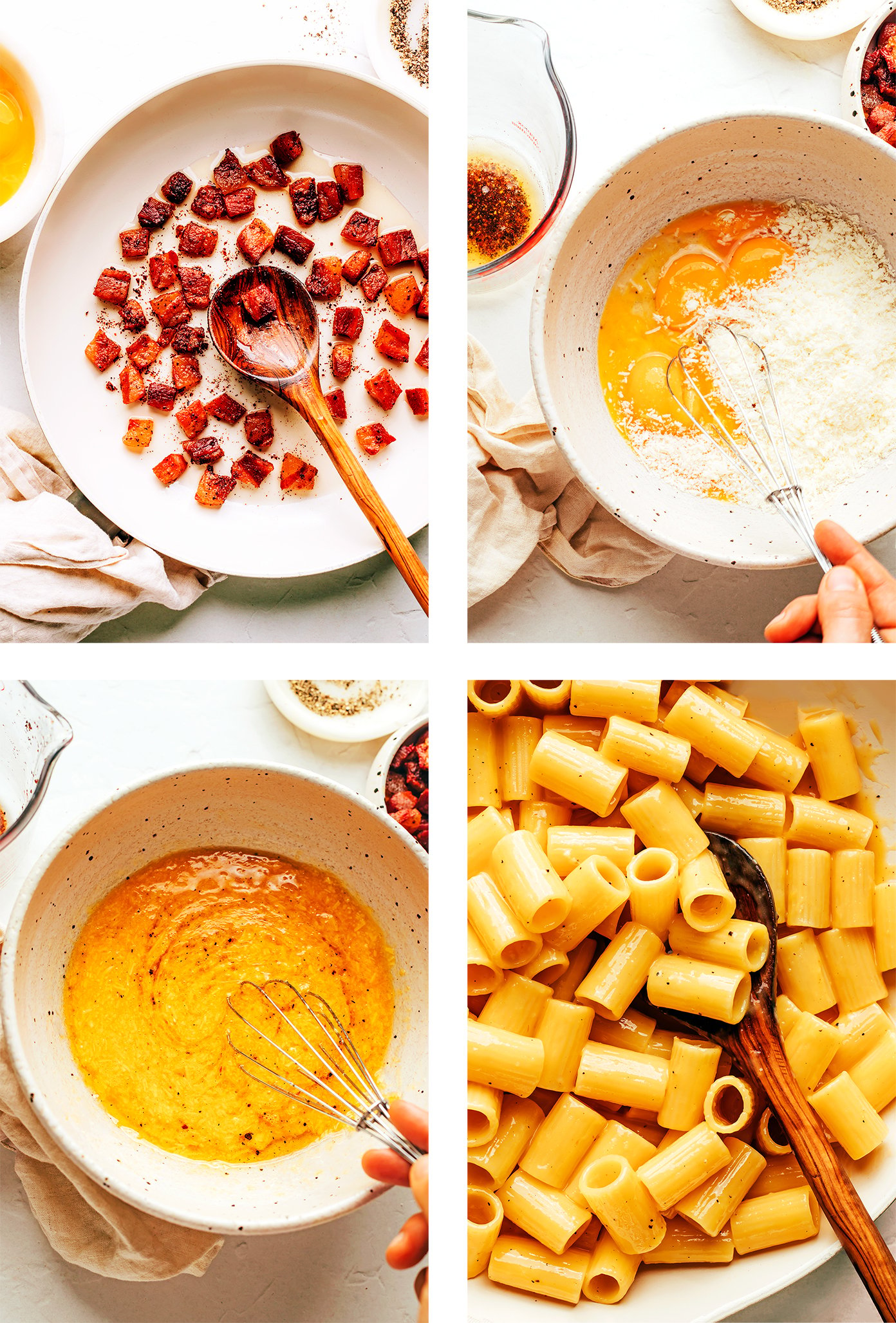
How To Make Carbonara
I’ve made carbonara over the years using more methods than I can count. But I’ve found that this double boiler method — slightly adapted from the method used by Luciano Monosilio — is the most reliable I’ve found so far to create a silky, glossy egg sauce. And, most importantly, avoid scrambling the eggs.
The full instructions for how to make carbonara are detailed in the recipe below. But here are double-boiler steps you will need to follow specifically for cooking the egg sauce:
- Mix the sauce. Everything having to do with the egg sauce will take place in a large metal (or other heatproof) mixing bowl. First, whisk together the eggs and egg yolks. Then, while whisking the eggs with one hand, slowly stream the reserved guanciale grease into the eggs with the other hand until combined. Next, while continuing to whisk the egg mixture with one hand, slowly stream one ladle-full (1/2 cup) of the starchy pasta water into the egg mixture with the other hand until combined.
- Quickly add the pasta. Once the pasta is about 1 minute shy of al dente, use a spider strainer or tongs in one hand to transfer the pasta directly from the stockpot to the bowl with the egg sauce, while using the other hand to toss the pasta with the sauce.
- Cooking the pasta and sauce. Immediately place the metal bowl on top of the stockpot that has been left behind with the starchy pasta water. This basically functions as a double-boiler, as the steam from the hot water will heat the bowl with the pasta. Continue tossing the pasta and guanciale continuously until the egg sauce has thickened. Then immediately transfer the pasta to your serving bowls. (If it sits for much longer in the hot bowl, it may begin to accidentally scramble.)
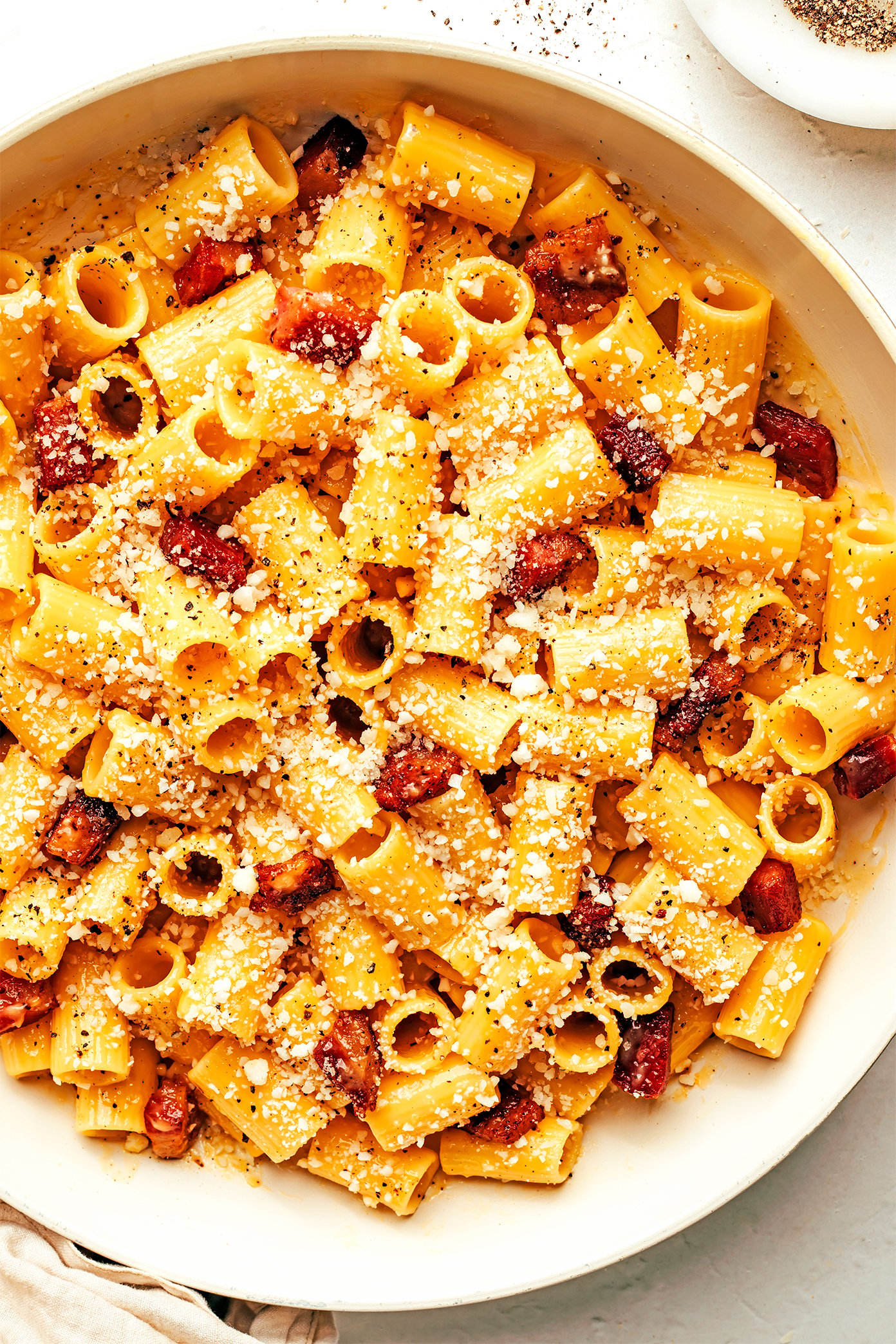
Pasta Carbonara Tips
Before we get to the full pasta alla carbonara recipe below, here are a few tips to keep in mind when making this dish:
- Read through the recipe first. This recipe is not difficult to make, but it does require a bit of multitasking that goes very quickly once you begin cooking the pasta. So I recommend taking a few minutes to read the entire recipe fully (especially the double boiler technique) before you begin cooking.
- Finely-grate the cheese by hand. As always, it’s important to grate the cheese by hand versus buying pre-grated cheese at the store (which usually contains anti-caking agents that prevent the cheese from melting smoothly). I recommend using a microplane or your preferred grater to finely grate the cheese just before adding it to the recipe.
- Don’t use too much pasta water. We want the starches in the pasta water to be very concentrated for this recipe, which will later help to emulsify the cheese sauce and adhere it to the pasta. So I recommend filling your stockpot no more than half full (about 3 quarts).
- Have a strainer or tongs ready to go. I find it’s much easier to use a spider strainer (or tongs, if using long noodles) to transfer the pasta directly from the stockpot to the sauté pan. But if you do not own either of those, you can use a heatproof cup to scoop out a few cups of the starchy water (it’s always good to reserve more than you need, just in case). Then you can drain the pasta in a colander and transfer it immediately to the sauté pan.
- Don’t overcook the pasta. Since the pasta will continue cooking slightly while it is tossed with the sauce, it’s important to keep a close eye on the pasta during the final few minutes of cooking so that you can transfer it over when it just 1 minute shy of al dente.
- Be very careful not to scramble the eggs. As mentioned above, be extra-careful when adding hot liquids or pasta to the eggs not to let them scramble! The key is to incorporate any extra heat gradually and never let the pan (or metal bowl, in this case) holding the egg sauce overheat. I believe you will have success if you use the double-boiler method included in the recipe below.
- Serve immediately. This pasta is definitely best served immediately hot out of the pan, so dish it up as soon as the sauce has thickened and enjoy!
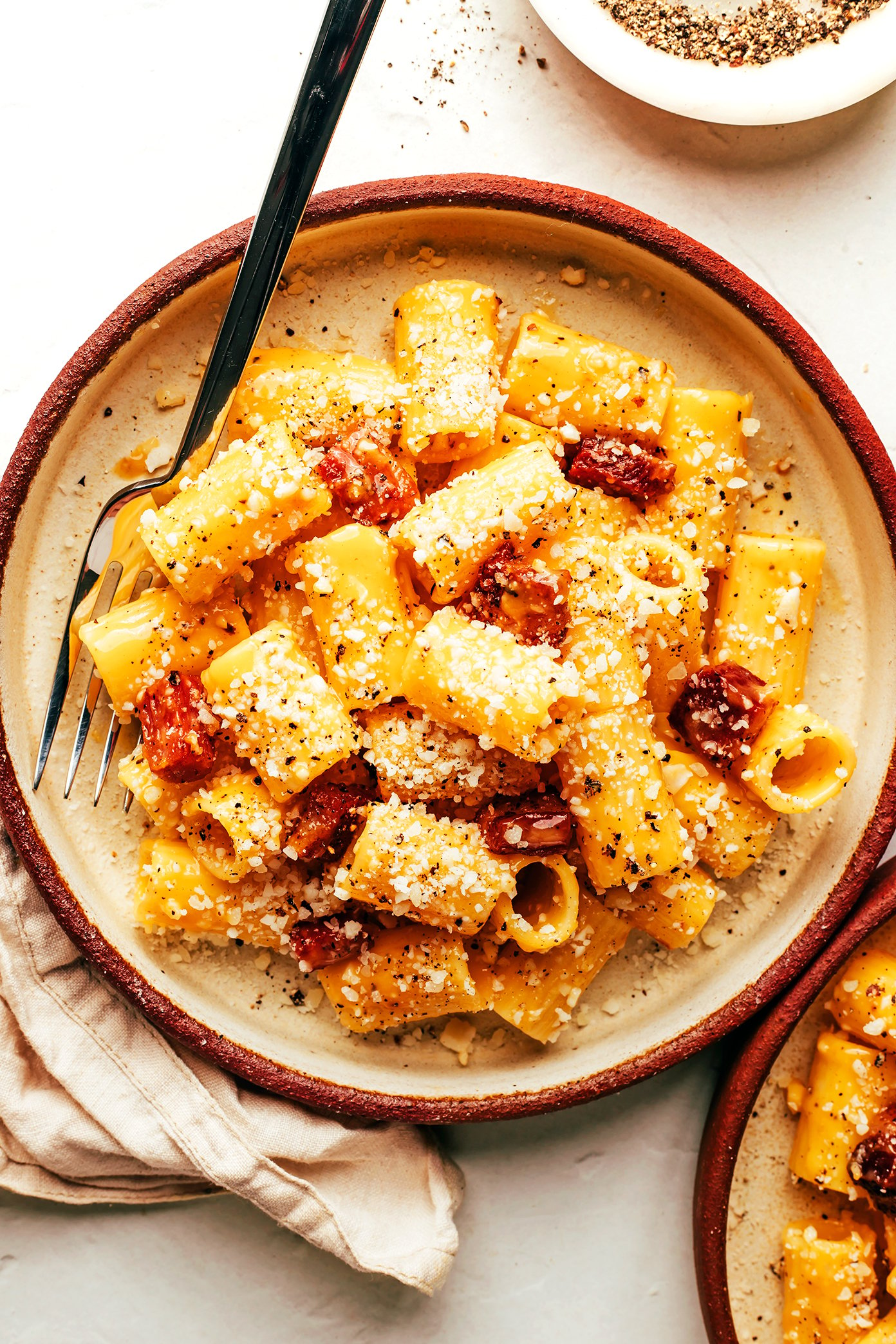
Carbonara FAQ
How do you pronounce “carbonara”? The correct carbonara pronunciation in Italian is “kahr-boh-NAH-rah.” (Here’s an audio example.)
What does “carbonara” mean in Italian? The name of this dish is derived from the Italian word carbonaro, meaning charcoal burner.
Where did pasta alla carbonara originate? The historical origins of this dish are fairly controversial, as is the case with most of the four Roman classic pastas. You can read more about a few of the most popular myths here, but more than likely, historians believe the dish originated in the mid-20th century in postwar Rome.
Why did my carbonara scramble? Carbonara sauce scrambles when the eggs are heated too quickly. Be sure to quickly whisk the eggs while gradually (not too fast!) adding in the guanciale grease and starchy pasta water. Then once you move on to tossing the pasta with the sauce, keep a very close eye on the sauce and as *soon* as it thickens, remove the bowl from the heat and transfer the pasta to your serving dishes.
Can I add cream to my carbonara? Noooo, this is unheard of in Rome, and it’s also completely unnecessary. The egg sauce will be plenty creamy on its own when properly mixed with the starchy pasta water.
What if I can’t find guanciale? As mentioned above, guanciale is one of the key ingredients that makes traditional pasta carbonara so special. But if you can’t find guanciale in your local stores, pancetta or a good thick-cut bacon can be used as a substitute.
What can I use instead of Pecorino Romano? This sheep’s cheese is always used in the traditional Roman pastas and, in my opinion, tastes best here. But if you are unable to find Pecorino Romano, I’ve also tried making this recipe using freshly-grated Parmesan (Parmigiano Reggiano) and it was delicious.
The 4 Roman Pastas
Interested in trying out all four of the classic Roman pastas? These traditional recipes won’t let you down!
Description
This pasta alla carbonara recipe easy to make with 4 classic ingredients and tastes so decadent and delicious.
- 12 ounces (340 grams) uncooked pasta (I used mezze rigatoni)
- 2 large eggs
- 4 large egg yolks
- 2 ounces (60 g) freshly-grated Pecorino Romano cheese, plus extra for garnish
- fine sea salt and freshly-cracked black pepper
- 8 ounces (225 g) guanciale, diced into ½-inch cubes
- Cook the guanciale. Heat a large sauté pan (preferably nonstick) over medium-low heat. Add the guanciale to the pan and cook, stirring and flipping occasionally, until the guanciale is golden brown and crispy and the fat has rendered, about 10 minutes. (Keep a close eye on the guanciale so that it does not burn.) Using a slotted spoon, transfer the guanciale to a clean bowl.
- Bloom the black pepper. Add 1 teaspoon freshly-ground black pepper to the pan with the hot grease, then turn off the heat.
- Boil the pasta. Meanwhile, fill a large stockpot about half full of lightly-salted water (roughly 3 quarts) and bring it to a boil. Add the pasta and cook for 8 minutes, stirring occasionally.
- Mix the sauce. Meanwhile, whisk the eggs, egg yolks, and Pecorino together in a large metal mixing bowl (or other heatproof bowl) until combined. Using one hand, gradually pour in the black pepper guanciale grease into the bowl while using the other hand to whisk the mixture until combined. Once the pasta has cooked for 5 minutes, remove ½ cup of the starchy pasta water and gradually pour it into the egg mixture while whisking until combined.
- Quickly transfer the pasta. Once the pasta is about 1 minute shy of al dente, use a spider strainer or tongs with one hand to quickly transfer the pasta to the metal bowl, while using the other hand to continuously toss the pasta with the egg mixture. Add the cooked guanciale to the bowl as well.
- Finish the pasta. Turn off the heat under the stockpot used to cook the pasta (the cooking water should still be in the stockpot). Then carefully place the metal bowl with the pasta directly on top of the stockpot, like a double boiler, so that the steam from the cooking water will heat the bottom of the bowl. Use tongs or a large spoon to continuously toss the pasta until the egg sauce begins to slightly thicken (watch it very closely so that it does not scramble). Then once the sauce has thickened, immediately remove the bowl from the stockpot and transfer the hot pasta into your serving dishes.
- Serve. Serve warm, garnished with an extra sprinkle of cheese and a twist of black pepper.
Notes
Recipe edits: Recipe updated in 2022 to include less pasta (original recipe used 1 pound, which was reduced to 12 ounces for a richer sauce-to-pasta ratio) and revised instructions (I’ve found this new method to be more reliable). I’ve also included a double-boiler method inspired by Luciano Monosilio.

